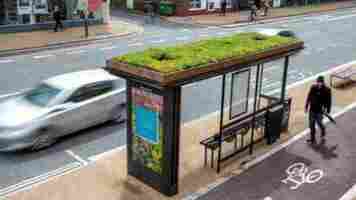How your city will transform as mobility tech catches on
Parking prices, congestion charges, fuel stations – the costs and diversions one never had to face on their way to work in the age of horse and carriage. The switch from horse-riding to automobiles changed the kind of materials used to build roads – slippery asphalt replaced cobbled streets and dirt roads.

Autonomous driving and other new transportation modes are key technological megatrends in the infrastructure industry. This calls for the built environment to adjust to these latest mobility technologies as they shape the future of roads and real estate construction.
In the public sphere, assimilation to these new technologies in mobility has already begun in the regulatory space. Nations across Asia, Europe and North America for example have already issued autonomous testing permits and offered regulation for self-driving cars on public roads .
Emerging mobility is also at the nexus of the proliferation of smart cities. The growth of smart cities is already calling for changes and adaptations by the construction industry. Similarly, the construction industry needs to be agile in the business models it uses as it adapts to trends such as automated, connected and electrified mobility.
Vehicle automation is already being recognized for use on construction sites, indicating the use of these technologies will dominate how the construction industry works in the future. For example, the advent of electric cars created the necessity for charging stations overnight and, only now, has been incorporated into planning, permission and housing development initiatives.
Changes in the built environment are also due to come from changes in behaviors around car proprietorship. Urbanites perceive cars more as a service to use and less as a good to own. The popularity of rideshare, car hailing services and apps such as Uber are a testament to this. In a world where private car ownership is reduced, so is the need for parking, and traditional parking structures become dinosaurs that need to be torn down or repurposed.
Significant changes in the mobility industry have come in the form of investment, with billions spent on autonomous vehicle (AV) technologies by automobile manufacturers across the world including Mercedes-Benz ($3.04bn) , Volkswagen ($54.2bn) Toyota ($4.32bn), Ford ($5.39bn), and GM ($1.5bn).
“Playful” investments such as Toyota’s prototype smart city at the bottom of Mount Fuji, Woven City, also show how these actors are beginning to recognize the importance of the built environment in accommodating their mobility technologies.
Other industries have also taken interest in the mobility space, such as Google’s Waymo self-driving technology. These shifts alongside the prospects of improved driving safety and efficiency in mobility make it clear that the advent of technologies such as autonomous vehicles is not far, even if profound technological (and legal) hurdles still remain, and timelines for Level 5 autonomy have admittedly slipped.
This begs the question, how ready is the built environment for some of these changes?
What the construction industry needs to be aware of
It would be sensible for the construction industry to embrace these changes with some modicum of preparedness. The growing call for employee safety, filling the skills gap, sustainability and more in construction, mean that the sector needs to embrace innovations such as those coming from AVs and emerging mobility. Ignoring such market changes will be at unprepared firms’ peril.
To remain efficient, business operations will require short-, medium- and long-term preparations for the AV construction space. Influences range from supply chain impacts, to sustainability in construction.
Space reallocation will come in varied forms such as the reduction of dealerships and parking garages, both public and residential alike. The unlocking of urban land from space reallocation will affect the dynamics of the housing market, such as the increased availability of urban housing. This will also affect the distribution of real estate prices whether looking at land prices or rents, and rearrange urban densities (for example suburban properties become more attractive when the time cost of commuting is cut down due to the use of AV vehicles).
Transportation can operate 24/7 in a fully AV world, allowing more to be done in less time in logistics and supply chains. This impact on the transportation of building products could reduce construction costs in logistics, and improve management of timelines.
There will also be shifts in the kinds of demand for construction work, such as which areas of infrastructure will require upgrades, and which would require outright replacements.
In a fully electrified transportation future, traditionally recognised sources of road infrastructure funding such as fuel taxes will falter. Government funding investment in construction and other sectors will be affected by these changes in funding models.
Some of these changes will be opportunities, such as the unlocking of urban land for new construction as petrol stations and dealerships become things of the past in a new mobility future. Other changes will be hurdles to cross such as the pressure on highways and transport infrastructure to keep up with the rapidly changing technologies; a call to future proofing construction.
The point is that market patterns in construction will shift due to emerging mobility.
A recent consumer market research study by H+C., an international autonomous vehicles and urban mobility consulting firm, shows that consumers think dedicated AV-only lanes are a good idea, implying that the population is ready for the mobility revolution that is already under way.
Psst, mobility nerds, here are the 4 books you HAVE to read
The holiday period is upon us and hopefully that means you’ve got a bit more time on your hands, can put down your computer, and pick up a book.

If you’re interested in the world of mobility tech, EVs, self-driving cars, and have no idea where to start, let me point you in the right direction with some recommendations from the experts.
1. Sensors in Automotive
Earlier this year, we interviewed human-machine interaction PhD researcher, Liza Dixon. Her field of research specifically examines how drivers and automated vehicle systems can work together. Hopefully, the insights gained through her research will help lead to the design of safer autonomous vehicles.
Even though I asked for one recommendation, Dixon went off brief and suggested two books: Sensors in Automotive and Rebooting AI.


Sensors in Automotive takes a rather holistic look at how sensors, like LiDAR and cameras, are used in the automotive sector. Specifically, it looks at how sensing and decision-making tech can assist drivers and road users to make safer vehicles.
It includes a forward by Euro NCAP’s secretary general, features tech papers from ARM, Intel, and Nvidia, and includes interviews with key market players. If you want a broad overview of a niche topic that affects pretty much every new form of mobility tech, Sensors in Automotive is a good place to start.
2. Rebooting AI
On to Dixon’s second recommendation: Rebooting AI: Building Artificial Intelligence We Can Trust .
This piece of recommended reading is a little off-piste, but Dixon makes a valid argument for its inclusion here.
Without artificial intelligence technologies and programming, autonomous vehicles would be in an even more distant future than they are already. Often, a lot of what we know about the potential of this tech is misguided or overhyped.
“Rebooting AI takes a critical look at the current development approach to applications of AI which demand broad, robust intelligence and presents us with a better way forward,” Dixon told SHIFT. “[This book is] perfect for anyone interested in learning about AI and the next generation of technology. ”
So while this book isn’t specifically about mobility, many of the technologies it discusses are used in self-driving cars and are important to know about if you’re interested in the field.
3. Tactical Urbanism: Short-term Action for Long-term change
I also spoke to award-winning transport journalist, Carlton Reid . In his 30-year career, Reid has covered everything from public transport, to bicycles, to developments in infrastructure.
As such, his recommendation focuses very much on how we can change our cities to improve how we get around them.
Tactical Urbanism: Short-term Action for Long-term Change , is a call to arms for activists that want to augment their cities to improve the lives of their residents.
During lockdown, we’ve seen bike lanes and low traffic neighborhoods spring up in Paris, New York, and London. Heavy-duty planters have been used to block off streets to cars, and allow pedestrian traffic through.
This simple and often activist-led reorganization of our urban landscapes is tactical urbanism. As Reid tells me, this book is ever more pertinent to the times we live in.
4. High and Mighty: The Dangerous Rise of the SUV
If you’re into the EV space, you should certainly know the name Auke Hoekstra . He’s a Dutch researcher from the Eindhoven University of Technology, and has fondly been referred to as the “decarbonization debunker.”
His detailed Twitter threads cast a critical eye over the developing world of electric vehicles, and regularly takes the challenge to anti-EV campaigners and climate change deniers.
When I pressed Hoekstra for a recommendation, he suggested High and Mighty: The Dangerous Rise of the SUV . Its name is pretty self-explanatory, but for the sake of clarity, this book takes a look at the detrimental impact that big sports utility vehicles have had on our roads.
Of course, SUVs do have their benefits and upsides, but there are also plenty of downsides that we need to be aware of. This book shines a light on those very characteristics. The future of mobility isn’t just about electrification, it’s also about efficiency of space and resources.
“[The book] shows how marketing and politics led to a worldwide interest in unusually large, fuel inefficient, and dangerous cars,” Hoekstra says.
Indeed, if we’re going to understand how the future of mobility and transportation might look, it’s important to understand where we may have gone a little wrong in the past.
Hopefully, there’s something in this list that tickles your fancy, whatever the case it gives an insight into the types of books the experts are reading.
SHIFT is brought to you by Polestar. It’s time to accelerate the shift to sustainable mobility. That is why Polestar combines electric driving with cutting-edge design and thrilling performance. Find out how .
Leicester installs bee-friendly bus stops
This article was originally published by Christopher Carey on Cities Today , the leading news platform on urban mobility and innovation, reaching an international audience of city leaders. For the latest updates, follow Cities Today on Twitter , Facebook , LinkedIn , Instagram , and YouTube , or sign up for Cities Today News.

The UK city of Leicester is installing 30 “living” bus shelter roofs as part of a new programme to revamp its infrastructure while supporting the environment.
Working with advertising firm Clear Channel , the so-called “bee bus stops” will be planted with a mix of wildflowers to attract pollinating insects and add extra greenery to the city.
The City Council says the shelters will positively contribute towards biodiversity and climate resilience, absorb rainwater falling on the roof, and help to reduce the “urban heat island” effect by capturing harmful particulates from the air.
Living roofs
Deputy City Mayor Cllr Adam Clarke, Environment and Transportation Lead, said: “This is just one of many benefits of the citywide revamp of our bus shelters.
“The new, modern shelters will be great for passengers and the mix of solar power and living roofs is another step forward for our ambition to be a carbon neutral, biodiverse and climate-adapted city by 2030.”
The council is also fitting bus stops with solar panels and smart lighting – where feasible – to cut energy use.
Installation of the living roofs is part of a ten-year contract with Clear Channel, and the firm will absorb the cost as part of a multi-million-pound investment overhauling the city’s 479 bus shelters.
Work on the 30 roofs is expected to be completed by summer, and a full revamp of all of the city’s bus stops is planned to be delivered by late 2022.
Will Ramage, Clear Channel’s Managing Director, said: “We know that true change comes when we start to roll out these types of innovation at scale.
“We’d love to see the living roofs in every town and city across the UK and Europe, having a tangible and positive effect on our planet.”
Several European cites, including Utrecht, have undertaken similar initiatives, with the Dutch city transforming 316 bus stops with living roofs in 2019.
Bee Roads
The new bus stops are part of Leicester’s ongoing “ Bee Roads ” programme, which to date has seen over 5.5 kilometres of roadside and roundabouts across the city planted with wildflowers to help make the city a haven for pollinators.
The project started in 2017 as a partnership between the council and the environmental charity Buglife .
In March, the charity launched its interactive B-lines tool, which is committed to increasing the number of ‘insect superhighways’ running through the UK’s cities and towns.
Do EVs excite your electrons? Do ebikes get your wheels spinning? Do self-driving cars get you all charged up?
Then you need the weekly SHIFT newsletter in your life. Click here to sign up .